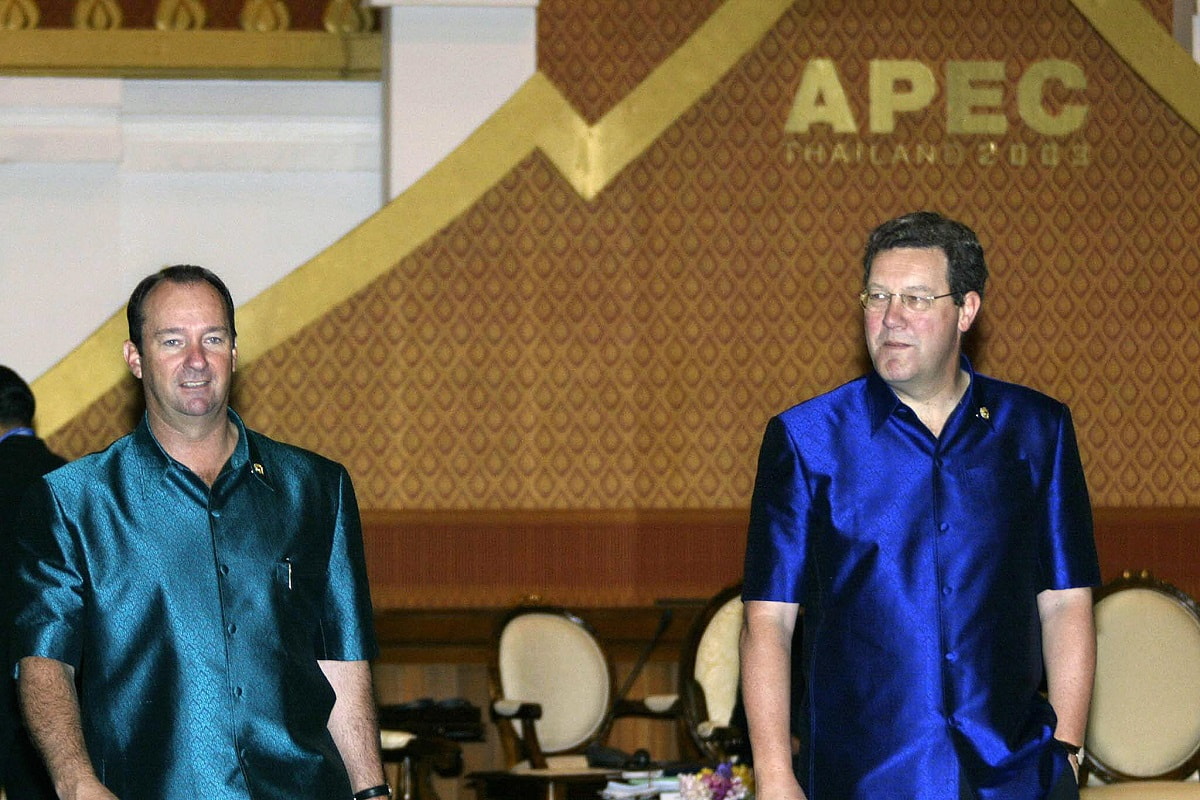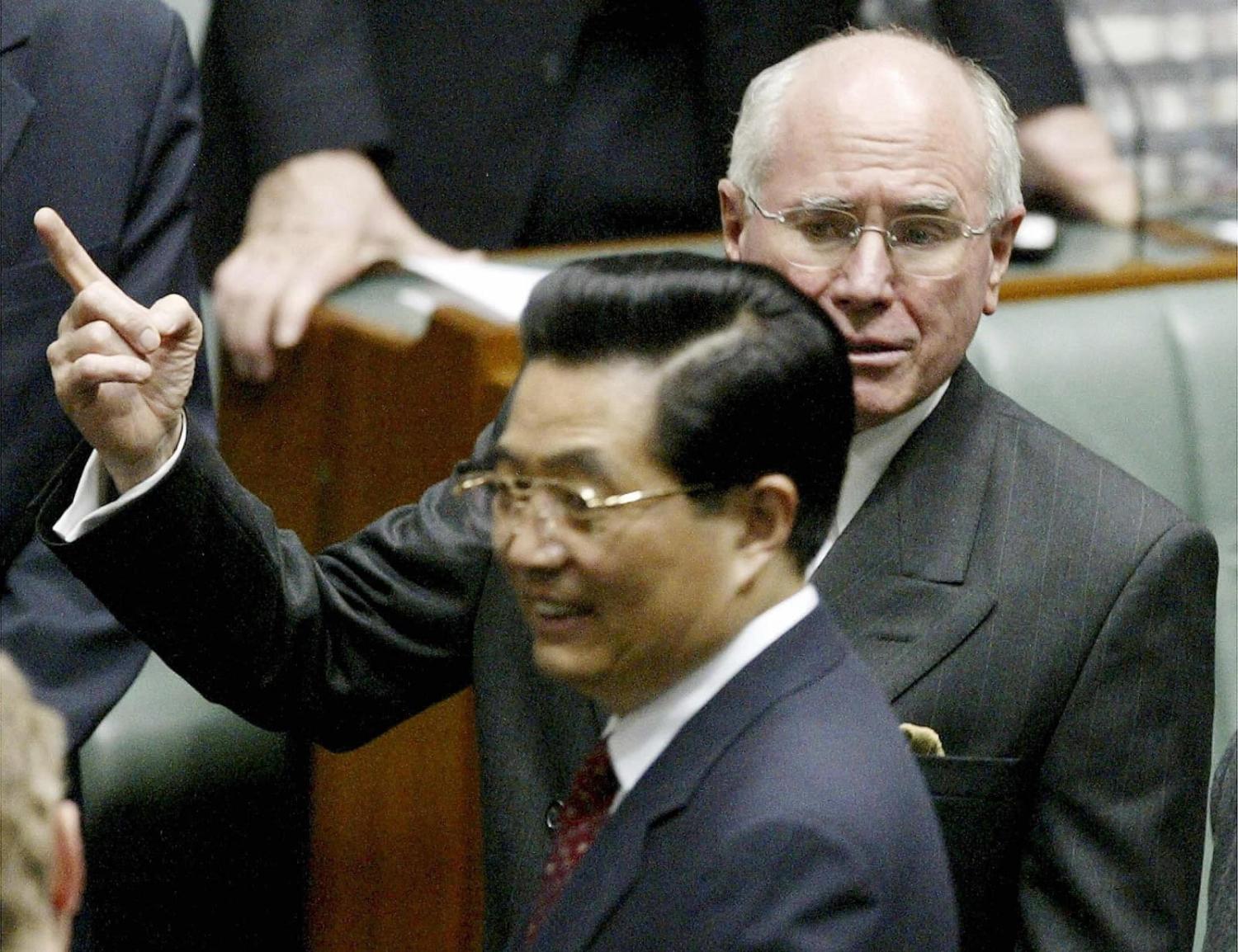Trading up
Australia’s international economic engagement kicked off in 2003 with then foreign minister Alexander Downer telling his Cabinet colleagues that he was set to claim the biggest trade policy agenda in Australia’s history.
Missing documents from the Howard government decision to join the Iraq war that year have dominated this year’s release of the 20-year-old Cabinet papers. But the records that are there show that this was also the year when the now common political practice of bilateral trade deal point-scoring began to take shape.
While the point-scoring wasn’t really a thing until after a future conservative government came back to power in 2013, the Cabinet papers underline how 2003 was the year when trade deals with the United States, China, Japan, Thailand and Singapore all gained momentum as multilateral negotiations built around the World Trade Organisation withered.
Downer made his trade claim in the February Cabinet briefing on the 2003 foreign policy white paper where he said the document would demonstrate “that the Government has developed the most ambitious and wide-ranging trade policy agenda of any government in Australia’s history”. Then Downer wrote the pitch that just about every trade minister has used since: that Australia’s “active pursuit” of bilateral liberalisation will “stimulate multilateral liberalisation”.
And there are a couple of other curiosities in the Cabinet review of the draft white paper in the light of later regional relationships. One is a Cabinet instruction that the first reference to New Zealand should emphasise that “we remain two sovereign, separate countries, with all that implies”. The other is that it was the Department of Defence, rather than others, that made the case for Australia’s role in the Pacific to be “more explicitly recognised to highlight its importance and relevance to us”.

The China moment
The big trade development of the year was the rapid progress on the bilateral agreement with the United States as the Howard government arguably quickly cashed in its chips from its support for the Iraq war.
But the seminal moment is a conservative government taking the first steps towards formally recognising as a “market economy” what its modern descendants now routinely refer to as Communist Party-run China.
China became a member of the World Trade Organisation in 2001 and quickly wanted to enjoy full trade benefits under the system. In 2002, one-time China sceptic turned minerals export enthusiast Prime Minister John Howard agreed to a framework study for a possible bilateral trade agreement. By mid-2003, the pressure was on for some substance with China’s President Hu Jintao due to address Parliament in late October.
On 9 October, trade minister Mark Vaile told Cabinet: “China maintains it could not agree to an FTA study, and much less FTA negotiations, unless Australia agrees to recognise China as a market economy, and not to apply certain provisions of its WTO Accession commitments to bilateral trade. No other major country has recognised China as a market economy.”
The documents show the ministers were concerned about criticism from other major countries if they made this concession. And in contrast to the business pressure for more China engagement in more recent times, there was also concern business would react badly to any limits on Australia’s dumping regime against Chinese exports.
But the Cabinet agreed a concession had to be made to get China to do more than vaguely “seriously study” a trade agreement and to actually embark on a feasibility study with a deadline. “Such a concession would involve Australia agreeing, either permanently or for a limited period, not to apply the specific provisions in China’s WTO accession package relating to anti-dumping and safeguards to bilateral trade. In addition … it may be necessary to indicate, on a prospective basis, that Australia would be willing to recognise China as a market economy,” the favoured Option B recommendation says.
“Opposition to closer trade ties on human rights grounds should be rejected directly and forthrightly on national interest grounds, pointing to the employment and growth benefits already generated by our trade with China.”
- Cabinet draft communications strategy
While nervous about breaking new ground on the market economy issue, the Cabinet was much more blunt about not linking a trade deal with human rights. The draft communications strategy on the proposed trade deal study says: “Opposition to closer trade ties on human rights grounds should be rejected directly and forthrightly on national interest grounds, pointing to the employment and growth benefits already generated by our trade with China.”
By 2005, Australia recognised China as a market economy shortly after New Zealand was the first developed country to do so – although the much sought bilateral trade agreement was not to be settled until 2013. The United States and the European Union continue not to grant China market economy status, and the Howard government’s initiative became decidedly more awkward as China imposed its trade impediments on another Coalition government in 2020.
All the way with USA
Earlier in the year on 3 March, the Cabinet agreed to pursue a trade deal with the Bush administration in Washington noting there was “very broad industry support” – in contrast to the tentativeness about the later China discussions.
There is no reference to the Iraq war context in the trade deal Cabinet submission but a considerable focus on trying to get the negotiations completed by early 2004 before the next presidential election campaigning began.
And the seeds of what would become a relentless shift from Australia’s traditional support for multilateral negotiations to bilateral deals was there from the beginning.
The Cabinet submission says: “The WTO negotiations are travelling more slowly than we had hoped when the Doha round was launched … Similarly, APEC’s trade liberalisation agenda has stalled following the launch of the WTO round.” So, negotiation of an American FTA provided a way for Australia to “go further than would be possible in the near-medium term under the Government’s efforts through multilateral, regional and other bilateral trade negotiations.”
And at a time when the United States was still twice as big as China as both an export and import market for Australia, there was notable concern about how criticism of an American deal would be inconsistent with Australian interests in both Asia and the WTO.
And whatever the Iraq war goodwill amounted to, Vaile told his colleagues there was still considerable uncertainty about how hard the Americans would conduct the negotiations after their recent experience of bilateral dealmaking with Canada/Mexico and then Singapore. So, it was agreed the FTA would only be completed as a single undertaking to prevent the Bush administration officials trying to pick off individual industries or concessions or otherwise trying to isolate Australia.
And in an interesting ideological twist, the Howard ministers accepted that their 1997 strategic decision to exclude labour and environment provisions in any future trade deals would have to be adjusted for the Americans because they had a legislative requirement to seek such provisions in their trade deals.
The US agreement was signed in May 2004 and implemented in 2005 amid some criticism that the fast negotiation may not have produced the best outcomes for Australia.
Ground zero
Downer’s claim to be launching an historic year of trade change at the February Cabinet meeting was given some immediate substance by the signing off that same day of a newly negotiated text with Singapore.
This was Australia’s first bilateral trade deal since the Closer Economic Relations agreement with New Zealand in 1983, and tiny Singapore emerges as a carefully chosen counterparty for what would become Australia’s embrace of the bilateral pathway.
“Singapore had the most developed economy and the strongest regulatory framework in South East Asia, and was clearly willing and able to move more quickly than other ASEAN partners. It also lacked the barriers protecting sensitive sectors for trade in goods that would have made FTAs with North Asian economies such as Japan and Korea difficult to initiate,” the agreement analysis says.
Later in the year, 9 October was certainly a big day for implementing Downer’s agenda with a Cabinet briefing on Thailand’s sudden readiness to conclude a trade deal in addition to the China market economy issue and some hard decisions on what to offer the Americans to achieve the year-end deadline for that FTA.
Australia and Thailand had been negotiating since early 2002, but then Prime Minister Thaksin Shinawatra wanted an agreement to announce at the 21 October APEC leaders’ meeting and appeared to be threatening that Thai negotiators would be diverted to a US trade negotiation after that. The briefing warns after that “outstanding Australia–Thai matters would probably only be resolved once a solution for the problems had been reached with the United States, which could take some time. In the intervening period, Australian exporters would be faced with the prospect of less favourable treatment.”
And echoing the theme of the year, it pointed out the agreement was already “likely to deliver to Australia market access gains in Thailand and increases in economic activity at home faster than could be achieved through the WTO negotiations”. The two prime ministers duly announced a deal on 19 October that year.
Amid the relatively fast progress with Singapore, Thailand and the United States, and the threshold decision on China, the long haul with Japan was only getting under way.
On 19 March, Cabinet noted Japan was reluctant to commit to negotiations on a treaty-level FTA or even “any bilateral arrangement that includes the objective of agricultural trade liberalisation”. Vaile told his colleagues: “Japan’s approach has lacked ambition and so far has been frankly disappointing.”
Business representatives were pressing the government to persevere because of concern that the longstanding relationship with Japan could be hurt as both countries pursued FTA opportunities with other countries. If Japan made “small tactical decisions” on agriculture in other negotiations, the Cabinet submission warns, Australia could be in a squeeze.
The sense of frustration flows through this document as officials present the Cabinet with various initiatives to keep the free trade conversation going on in other places and so enable Australian officials to keep making Japan think about potential damage to the existing relationship.
And as a final fallback, Australia would reluctantly agree to the Japanese suggestion of some form of arrangement to strengthen investment linkages. It would take until 2015 before the two countries could agree on a trade deal.
